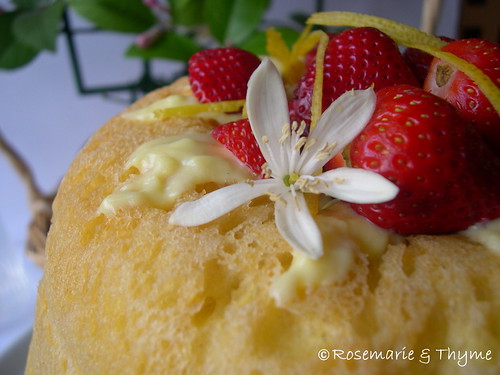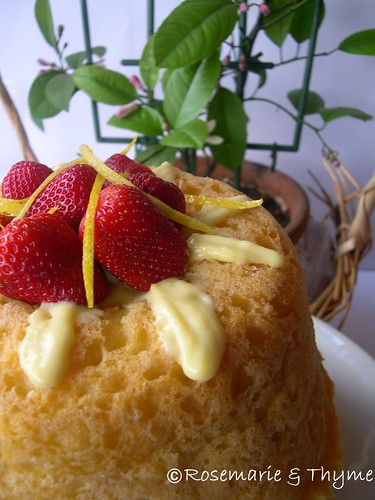Non so esprimere a parole quanto mi sia piaciuto questo piatto che è stato oggi il nostro pranzo domenicale.
Ottenuti sul filo di lana gli ingredienti all'ultimo minuto questa mattina...ho scoperto solo ora nel postare che ho preparato il piatto di marzo. Di marzo! Vi rendete conto? A marzo per la prima volta dall'inizio dell' MTC avevo saltato il turno e messo via i fogli già stampati della ricetta. L'ho riesumati ieri pensando che fosse la ricetta di aprile.
Un grazie speciale a Mai del blog Il colore della curcuma per avermi fatto scoprire questo piatto e le mie più sincere scuse ad Anne de The Food Blog che proponeva per questo mese la ricetta del Chili con carne che, prometto, farò mangiare a breva alla mia famiglia :))) Voglio vedere se Alessandra trova una foto di commento per il premio smemorata-incasinata-fuoriconcorso-rosy. Ale? Questo me lo devi!
PS Non ho messo l'uovo nella salsa alioli che è stata pazientemente preparata nel mortaio genovese della nonna del webmaster dal Siarhei (leggi Sergej).
Vi lascio alle parole di Mai.
Siete nel 1915, dentro la cambusa di un peschereccio e state navigando sul mare mediterraneo, nelle coste dei paesi catalani*. Fuori l'aria è salata e fresca. Tra poco dovrete servire il pranzo. Voi siete i cuochi, dovete cucinare per il capitano e i pescatori. Nel vostro calderone non mancano mai il pesce fresco di giornata, il brodo e mezzo pugno di riso a testa. Peccato però che il capitano pensi solo per sé mangiando sempre più del dovuto, lasciando gli altri a digiuno! Al capitano piace assai il riso col pesce… ma se invece del riso la prossima volta ci provate a mettere della pasta?
Immaginate...
Ci siete?
Fatto!
Nasce così la fideuà, da un pescatore di a Gandia (Valencia).
...LA FIDEUÀ
ingredienti per 6 persone:
600 gr. di "fideus" (potete farli spezzando degli spaghetti, 2/3 cm)
5 pomodori maturi
1 o 3 spichi d'aglio (a piacere)
350 gr. di calamari
350 di gamberi (io mazzancolle)
6 gamberoni
1/2 cucchiaino di paprica dolce
un pizzico di pistilli di zafferano
sale olio extra vergine
brodo
1 cipolla media
aqua, sale
pesce di roccia
(perché è più saporito, ma io mi sono adeguata a quello che ho trovato nel mercato:
tracima, muggine, razza, scorfano, nasello e qualche scarto di pesce spada e qualche testa di gambero)
per la salsa alioli
1 spichio d'aglio (ma se vi piace il sapore forte anche 3)
olió extra vergine (quanto basta per legare la salsa sui 100 ml)
sale
il rosso di un uovo (facoltativo)
Procedimento…
Mettere il pesce per il brodo in una pentola piena d'acqua fredda (2 l.) aggiungere la cipolla, sbucciata e fatta in 4 pezzi grossolani. Potete mettere anche qualche testa di gambero, per renderlo più saporito. Portare a ebollizione e togliere la schiummetta che si forma sopra, cuocere per 30/40 minuti. Dopo filtrare e tenere da parte a caldo.
Nella "paella" scaldare un filo d'olio, versarci i fideus e farli tostare il più omogeneamente possibile, devono diventare sul marroncino ma attenzione a non brucciarli troppo. Poi mettere da parte.
Aggiungere olio alla paella e cuocerci i gamberi, salare verso la fine e mettere da parte. Conviene munirsi di un recipiente, meglio con coperchio, per preservare il pesce cotto e mantenendolo caldo. Se serve, aggiungere olio e cuocere i gamberoni, salare verso fine cottura e mettere in caldo. Passare ai calamari, puliti e fatti a pezzi, (ad anelli per capirci…) salare anche questi a fine cottura e unire al resto del pesce. Fate attenzione alle diverse cotture, il pesce fresco cuoce velocemente, ve la cavate in pochi minuti, ma aggiungete sempre abbastanza olio, perché vi servirà anche per il soffritto.
Lavare e sbucciare i pomodori. Se li fate sbollentare qualche minuto in acqua bollente è molto più facile, se non avete voglia potete usare il pela patate. Tagliuzzateli piccoli, piccoli. Sbucciare lo spicchio/spicchi d'aglio, fateli fini fini e soffriggere nell'olio, dopo qualche secondo aggiungerci i pomodori. Aggiungere una punta di zucchero, e più avanti correggere di sale. Se è necessario, (e lo sarà) bagnare con del brodo di pesce.
Quando il soffritto ha cambiato colore, si è ridotto e addensato, versare lo zafferano pestato nel mortaio e sciolto con un filo di brodo, amalgamare e aggiungere mezzo cucchiaino di paprica dolce. Dopo di che va versato il brodo, il sufficiente a coprire a pena a pena la pasta quando la andremo a buttare. Dovrete regolarvi a secondo la pentola o padella che avete a disposizione, ma meglio se questa è bassa e larga.
Quando il brodo comincia a sobbollire buttare la pasta, disporla omogeneamente su tutta la padella. Qui vanno controllati i tempi di cottura della pasta, la mia era 10 minuti, dopo i primi 4 minuti che cuoceva la pasta ci ho aggiunto i calamari e i gamberi, amalgamato e cotto fino ai 6 minuti restanti. Assaggiare se è giusto di sale e adagiare sopra i gamberoni.
La fideuà va sempre accompagnata dalla sua salsa, l'alioli, una salsina fatta soltanto con aglio, olio e sale, e tanto olio di gomito perché si fa dentro un mortaio. Ci vuole tanta pazienza e una trentina o quarantina di minuti. Di solito l'alioli lo fanno gli uomini di casa perché se una donna lo guarda la salsa impazzisce e si deve ricominciare da capo, ecco una buona scusa per dare un lavoretto ai maschi di casa:
-"Amore, tieni questo devi assolutamente farlo tu…!"
Si comincia con il mortaio appoggiato sul tavolo, pestando l'aglio 1o 3 spicchi, privi dell'anima e un pizzico di sale. Deve diventare una purea finissima, senza grumi. Dopodichè fate sedere il marito con il mortaio tra le gambe, in una mano il pestello e nell'altro l'oliera. Il preparato si deve girare e girare versando l'olio a filo, o meglio a goccia, sul mortaio ma non direttamente sull'impasto. Vedrete che dopo 15/20 minuti la salsa comincia a legare e a crescere. Magari il marito sarà stanco ma vi assicuro che l'orgoglio sarà salito con la salsa. Chiedete al tarantino...
Un'altra versione prevede l'aggiunta del rosso di un uovo. Questo va messo dopo che l'aglio è già purea, si amalgama e si procede con l'olio.
E per tutti quelli che sono stati valorosi e pazienti d'arrivare fino qua, se vi va, potete dare una occhiata al video, magari il profumo e la visione in diretta della fideuà vi aiuta nelle vostre creazioni! O magari rifate un'altra sessione di "training autogeno", tornate nella cambusa del peschereccio e guardatevi intorno. Prima però vi consiglio di andare a leggere tutte le regole e consigli dati dalle giudici del MTC.
Note e asterischi!
Vi consiglio di stare attenti al brodo, a mettere il necessario, meglio aggiungerlo in cottura a modo di risotto, che non metterne troppo, perché la pasta non riuscirebbe ad assorbirlo tutto e verrebbe una fideuà troppo brodosa.
Il pesce utilizzato per fare il brodo è quello che purtroppo ho trovato quel giorno. Il pescivendolo, che è sempre molto simpatico e cordiale, mi ha spiegato che essendo un periodo con molti maremoti e brutto tempo, il pesce di roccia fanno fatica a pescarlo. Ma devo dire che ho seguito i suoi consigli e il mix di pesci che mi ha dato più qualche mia aggiunta di qualche testa di gamberi è venuto molto saporito.
*...Con i re catalani, la corona d'Aragona prosperò e si espanse il modo che i suoi territori comprendevano Valencia, le isole di Mallorca, Sicilia, Corsica, Sardegna e Napoli. La corona d'Aragona divenne l'impero militare più potente e commerciale di tutto il Mediterraneo...".
Per un piatto così "giovane" la sua popolarità è tanta e tutti se ne prendono la paternità.
In realtà La fideuà non è proprio una ricetta catalana, ma si dei paesi catalani, tra i quali ne fa parte la Comunitat Valenciana, (lo stesso per la paella), in questo caso si da la paternità al cuoco di un peschereccio nativo di Gandia (Valencia).
Ringrazio tantissimo Ilaria e Alessio, due nostri amici, scelti non a caso per la loro pazienza e spirito di sopportazione, che carichi di telecamera e idee sono riusciti a fare "centinaia di riprese", e montare il video che vedete qua sotto.
Magari quella che presenta la ricetta non è il massimo, ma vi posso assicurare che le risate durante le riprese e dopo nel montaggio sono state tante, ma tante!
Anche se non so quale sarà la sua reazione la prossima volta che sentiranno "Fideuà" o "mortaio tra le gambe"!





